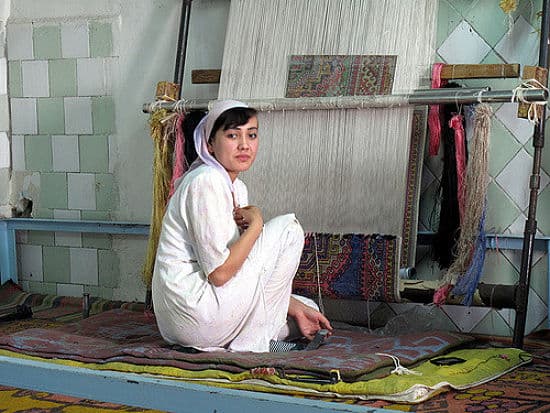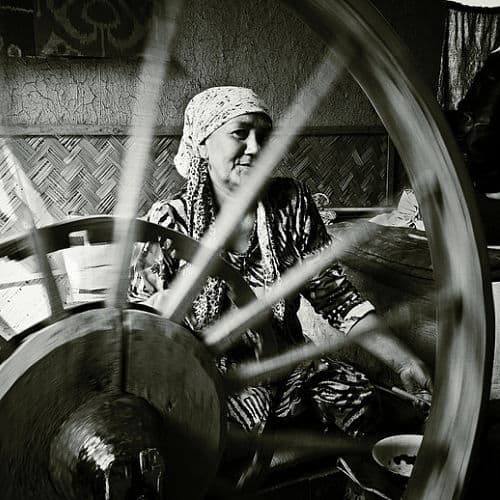When Vladimir Nalivkin, a Russian officer who had served in several military campaigns, and his wife, Maria Nalivkina, took up farming in 1878 in the village of Nanay in the Fergana Valley—in what is now known as Uzbekistan—there is little doubt that the couple embodied the deep transformation of a life world in the eyes of the indigenous people among whom they had voluntarily settled. As Tsar Alexander II completed his conquest of Central Asia at the end of the nineteenth century, establishing its imperial administration and bureaucracy in the remote areas of the former Khanates, the Nalivkins certainly felt a sense of urgency in preserving through their writings a world endangered by the forces of Russification that their very presence among the Sart—a historical name for the ethnic group that lives in the Fergana Valley—exemplified.
The tension produced by the couple’s genuine interest in local culture and customs and the imperial aims that made this encounter possible is precisely what makes Muslim Women of the Fergana Valley a riveting read.
Indeed, as the editor, Marianne Kamp, rightly argues in her introduction, “the authors wrote with all the hubris of Western cultural superiority but also with an attention to detail and effort at description that arose from genuine curiosity” (p. 1). Turning the pages of this picturesque book, I often found myself torn between excitement at recognizing patterns of culture I personally witnessed during my own ethnography of gender politics in contemporary Afghanistan and occasional disappointment at finding well-entrenched stereotypes about Central Asian women reproduced.[1]
The Nalivkins can be partially forgiven for these intermittent misrepresentations, for both were (albeit reluctantly) part of the Russian colonial administration and neither had received any formal ethnographic or Orientalist training prior to their settlement in the Fergana Valley.
Through his military education, Vladimir had nevertheless acquired useful topographic, linguistic, and observational skills. As for Maria, who had received a high school education in Saint Petersburg (a rare opportunity for a Russian woman at the time), it is evident that she played a key role in collecting most of the ethnographic material that served as the basis for the book. Indeed, as an unrelated male, Vladimir would simply not have been authorized to develop the proximity necessary for women to discuss child rearing, marriage, family relationships, and love affairs. Maria proved to be endowed with a natural ethnographic gaze, able to capture with great alertness cultural insights via the female neighbors she had befriended.

In spite of social constraints and oppressive circumstances, women are portrayed as resourceful, ingenuous, and even at times mischievous agents able to strategize and accomplish their own aims. Readers will be surprised by scenes in which women take off their headscarves, curse their husbands, and threaten them with divorce when the latter fail to offer them new clothes on the occasion of religious holidays or when they don’t bring enough mulberry leaves to feed the silk worms the women are in charge of breeding. They will be flabbergasted by the story of an alcoholic man abandoned by two of his three wives, who joined a brothel in the hope that “their life there would be more diverting” (p. 130), or by the one of a 40-year-old widow who decided to dress as a man, took over her departed husband’s business, and forced the local population to recognize her as a mirob-boshi, or head of irrigation systems.
Aware of widely held stereotypes about the plight of Muslim women among their fellow Russian compatriots, the ethnographers show that Islam’s role in shaping social behavior remains relative. In practice, the prescriptions derived from sharia are constantly negotiated according to immediate local needs.
For example, young women may refer to the religious norm according to which believers should take care of their appearance to justify personal beautification via the use of cosmetics and the purchase of adornments. On the other hand, women often find excuses to avoid having to perform nomaz (prayer) and do not hesitate to use the threat of divorce—a woman’s right in Islam—to put pressure on their husbands. Caught off guard by their discovery of their informants’ selective knowledge of the Koran and Islamic law, the Nalvikins come to the conclusion that “religious indifference has spread among the masses” and that “Muslim women’s situation is better and the range of personal rights is wider than it is for women of European peoples” (pp. 131, 122).
Of course, the Nalvikins were not immune to social evolutionist theories that emerged during the nineteenth century.
Regular references to local people’s lack of knowledge of elementary hygiene, arithmetic rules, anatomy, widespread illiteracy, and local superstitions were certainly perceived by the couple as signs of a “less advanced society” on the evolutionary scale that framed Western thought at the time.
But in spite of these shortcomings, the authors pioneered in a new genre of ethnographic writing using methods now broadly acknowledged as forming the very foundation of anthropological discipline. For this alone, and with the guidance of the editor’s introduction and annotations to put the text in its historical context, Muslim Women of the Fergana Valley is a must-read for students specializing in the history of Russia and Central Asia, women’s studies, and anthropology.

Photo by Peretz Partensky (flickr, CC BY-SA 2.0)
In 1918, Vladmir Nalivkin, who defended the autonomy of Turkestan’s ProvincialGovernment against the Bolsheviks’ attempt at regaining political control, committed suicide on his wife’s grave in Tashkent. This desperate act was a powerful symbol of the end of an era. But Nalivkin’s plea for preserving Central Asian “cultures” did not remain unheard. Indeed, forty years later, in Nukus, a small town located in the western desert of Uzbekistan, Igor Stavitsky, the Russian painter, archaeologist, and art collector, began collecting the works of Central Asian artists and, later, those of the Russian avant-garde whose paintings had been banned in the Soviet Union during Joseph Stalin’s rule, as shown in The Desert of Forbidden Art, a film by Tchavdar Georgiev and Amanda Pope (2010). The collection Stavitsky assembled at great risk was preserved, away from Moscow’s censors, in a Nukus museum. Like the Nalivkins, Savitsky had developed this intimate conviction that far from being fixed, bounded wholes, cultures necessarily rely on each other to thrive.
Notes
[1]. Julie Billaud, Kabul Carnival: Gender Politics in Post-war Afghanistan (Philadelphia: University of Pennsylvania Press, 2015). [2]. David Schimmelpenninck van der Oye, Russian Orientalism: Asia in the Russian Mind from Peter the Great to the Emigration (New Haven, CT: Yale University Press, 2010).First published on H-Net Reviews.
Vladimir Nalivkin and Maria Nalivkina (Edited by Marianne Kamp/ Translated by Mariana Markova and Marianne Kamp). 2016. Muslim Women of the Fergana Valley. A 19th-Century Ethnography from Central Asia. University of Indiana Press. 242 pp. Pb: $ 32.00. ISBN: 978-0-253-02138-0.
**********
Featured image (cropped) by Slava Myronov (flickr, CC BY 2.0)





